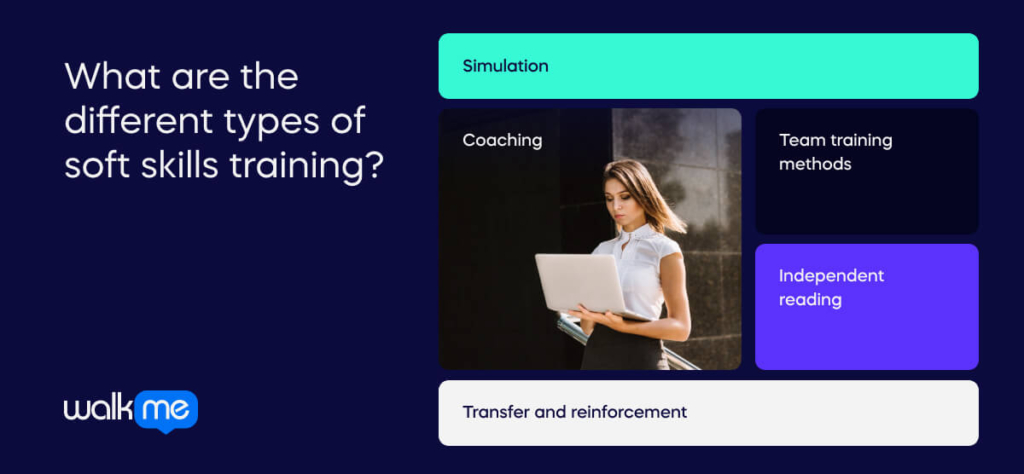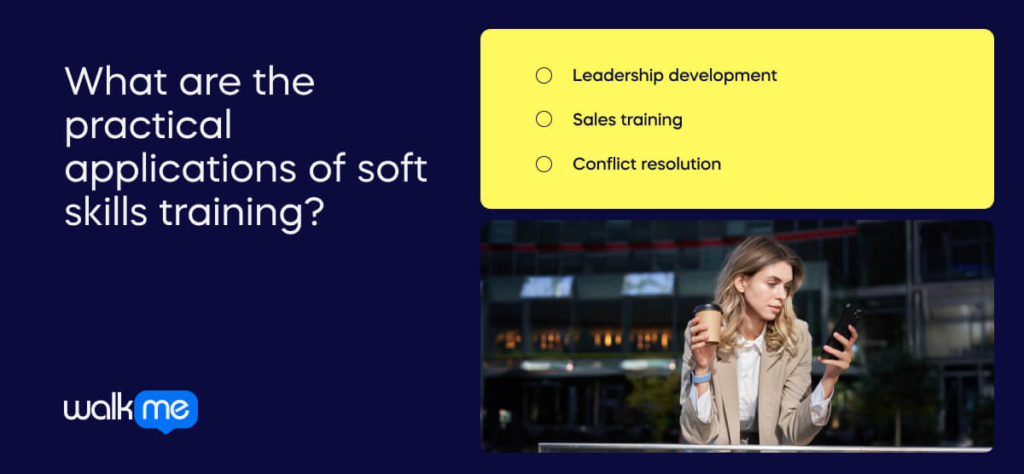Soft skills aren’t difficult to understand. After all, these are the qualities that make us human. The best workers often demonstrate excellent soft skills without any training intervention. However, it’s usually hard to see how they fit into plans for business growth and organizational development.
Moreover, many people think the key skills for tomorrow are “hard skills.” That is the technical know-how behind implementing prompt engineering, cybersecurity, or digital transformation.
Yet, as World Economic Forum research shows, soft skills like creative thinking, flexibility, motivation, and curiosity remain among the most important employee assets. Whatever ups and downs may come from new technology, geopolitical crises, and economic downturns, soft skills will help every employee be resilient and adaptable to new challenges.
In this context, this article will explain how organizational soft skills training helps meet the needs of tomorrow. It will:
- Define soft skills training;
- Introduce some of the key employee training methods for soft skills training;
- Explain the major training situations in which soft skills training is especially effective.
There are plenty of challenges involved in soft skills training. It can be an intensive experience that needs reinforcement, and leaders can face an all-too-common resistance to change. However, with the right employee training methods, employees can quickly enjoy the benefits of their newly discovered soft skills.
What is soft skills training?
While many types of training try to help employees improve their capabilities with specific tasks or processes, soft skills training helps staff develop their transferable talents in a range of areas. Soft skills are the personal attributes, characteristics, and interpersonal abilities that enable individuals to effectively interact with others, navigate social situations, and perform tasks in the workplace.
Out of the huge range of soft skills, some of the most important ones today include:
- Effective communication
- Teamwork
- Influencing without authority
- Problem-solving
- Leadership
In the modern workplace, very few jobs do not require effective soft skills. Developing these skills requires specific corporate training approaches.
What are the different types of soft skills training?

This section will introduce the best ways to implement soft skills training in your organization. In corporate training, the best methods of soft skills training should be interactive and participatory, with plenty of opportunities for feedback and evaluation.
However, individual staff members can also improve their soft skills through gentler processes of education, reflection, and practice.
With these factors in mind, some of the best types of training for soft skills are:
- Simulation
- Coaching
- Team training methods
- Independent reading
- Transfer and reinforcement
Some types of eLearning can also be useful for elements of soft skills training, as we discuss elsewhere.
Simulation training
Simulation training helps staff improve their capacity to deal with high-pressure situations. Soft skills are one of the important lessons that simulations teach. In a simulation, participants may feel many of the emotional ups and downs that they would experience when they are faced with the reality of the situation.
A good simulation will help staff apply their “hard” skills in an unpredictable environment, but they should also be invited to reflect on the emotional challenges that came with it. Simulations that specifically support soft skills learning in time management, teamwork, communication, and emotional intelligence can be created.
Coaching
Coaching has many core strengths when it comes to soft skills training.
It rapidly promotes self-awareness, encourages continuous growth, and enables individuals to apply newfound skills directly in their interactions.
It is especially useful for people who struggle to see the strengths and weaknesses of their own soft skills. Through one-on-one interactions, coaches can identify areas for improvement, offer targeted advice, and facilitate practical exercises to enhance communication, collaboration, leadership, and emotional intelligence skills.
Team training methods
Team training methods can support soft skills training by allowing all the participants to be present, vulnerable, and empathetic towards those around them.
Away days and retreats, for example, give staff time to interact in a relaxed setting, fostering open communication, collaboration, and relationship-building. Through team-building exercises, group discussions, and shared experiences, participants can develop communication, teamwork, problem-solving, and leadership.
The informal nature of these events encourages participants to step out of their comfort zones, explore new perspectives, and practice interpersonal skills in real-life scenarios.
Independent reading and reflection
Formal training interventions are not the only way to enhance soft skills. After all, many soft skills develop from a deep place of self-exploration.
As a result, informal reading can be an excellent way for individuals to improve their soft skills.
Training leaders can encourage this with some gentle steps. For example:
- Implementing a CPD library in your organization
- Internally publishing book reviews
- Making reading recommendations
This will help build deeper soft skills, knowledge, and expertise in your organization.
Reinforcement and transfer
Staff understand, retain, and develop their soft skills best when they actively use them. As a team of Dutch researchers explained in 2018, this is one of the major challenges for any soft skills training initiative. If employees don’t have the opportunities to apply the newly learned skills to their job roles (a process known as “transfer”), they will simply forget them.
As such, a strategic approach to soft skills training will ensure that employees can apply what they have learned. That could be through:
- On-the-job training methods such as job rotation
- Continuous training opportunities, including collaborative training, refresher sessions, and communications from leadership
- Including soft skills development in performance management strategies
A forgetting curve follows any successful learning intervention follows a forgetting curve. However, this is especially pronounced with soft skills. As such, ensure every employee has the opportunity to grow their soft skill set.
What are the practical applications of soft skills training?
Soft skills are valuable for all staff. No matter the employee’s role or pay grade, soft skills will improve your professional relationships, foster a positive work culture, and improve overall productivity and performance across teams and departments.

This section will illustrate the practical value of soft skills training in three key areas. We will look at soft skills in the following ways:
- Leadership development
- Sales training
- Conflict resolution
We will explain the important soft skills and how to implement training strategies to develop them in each area.
Leadership development
Effective leaders need a wide range of soft skills in their daily work.
Of course, managers need hard skills like technical knowledge, project management skills, and financial responsibility. But without good soft skills, they will never be able to build consensus, foster teamwork, or empathetically improve employee experiences.
The following list indicates some ways soft skills are important for leaders:
- Effective leaders must communicate clearly and persuasively to inspire and guide their teams. This includes active listening, articulating ideas, and providing constructive feedback.
- Emotional intelligence is vital. Leaders need to understand and manage their own emotions while also recognizing and empathizing with the feelings of others. This fosters trust, collaboration, and conflict resolution.
- Strong leaders are skilled decision-makers who can weigh options, analyze risks, and make timely, informed choices that align with organizational goals.
- Leadership often requires navigating change and uncertainty, so leaders must be flexible, resilient, and open to new ideas and perspectives.
Very few leaders will have all of these skills naturally. Leadership development programs should make a special place to learn such skills.
How to implement it
Leadership soft skills training is one element of a comprehensive leadership development program for most companies. To implement soft skills interventions for leaders, here are some of the most effective methods:
- Role-playing and simulation. Simulate real-world leadership scenarios where participants can practice decision-making, conflict resolution, and team management in a safe environment.
- Case studies and group discussions. Analyze case studies of successful leaders or challenging leadership situations, followed by group discussions to explore different approaches and lessons learned.
- Coaching. Pair participants with experienced leaders who can provide guidance, feedback, and personalized development plans to enhance their leadership skills.
Implementing these simple methods in a comprehensive leadership program will support much more effective leadership in the future.
Sales training
For any client-facing role, soft skills are vitally important. Customer-centricity is widely claimed as a route to customer success. But if your staff can’t talk to customers properly, all the software tools won’t help you.
This is especially true for the sales team, which guides new customers to make informed and comfortable decisions. Some salespeople are naturally talented takers and won’t need specialist sales training to get results.
However, a good education program for salespeople will make sure they are competent in the following soft skills:
- Communication. Effective sales professionals must articulate the value proposition of products or services, listen to customer needs, and persuasively convey information.
- Relationship building. Building rapport and trust with customers is essential for successful sales. This includes empathy, active listening, and understanding customer motivations.
- Negotiation skills. Negotiation is crucial for closing deals and reaching mutually beneficial agreements with customers. This includes problem-solving, flexibility, and assertiveness.
As you can see, many soft skills connect with others. This means that any targeted skills intervention will have a knock-on effect on other elements of employees’ skill sets.
How to implement it
If you’re trying to support soft skills development in your sales team, consider some of the following approaches.
- Shadowing and on-the-job training. Pair new sales hires with experienced mentors or supervisors who can provide guidance, demonstrate best practices, and offer real-time feedback during customer interactions.
- Sales coaching and feedback sessions. Schedule regular one-on-one coaching sessions to review sales performance, discuss challenges, and set goals for improvement, focusing on specific soft skills development areas.
- Continuous learning and development through eLearning. Provide access to online courses, webinars, and resources on negotiation tactics, communication skills, and emotional intelligence to support ongoing skill enhancement for sales professionals.
Remember that soft skills may develop slowly at first. That’s quite alright. Keep offering training, and your sales team will continue to grow in their understanding.
Conflict management
Finally, conflict management training helps workers combine soft skills and tested strategies to diffuse problems in their teams and workplaces.
Some of the key skills a trainee conflict manager will develop include:
- Active listening. Being able to listen attentively to others’ viewpoints without judgment or interruption helps one comprehend underlying issues and find mutually agreeable solutions.
- Empathy. Understanding and empathizing with the emotions and needs of others involved in the conflict can facilitate empathy-driven responses and foster cooperative problem-solving.
- Emotional regulation. Managing emotions and responding calmly and rationally in tense situations is crucial for de-escalating conflicts and maintaining constructive dialogue.
- Collaboration. Working collaboratively with conflicting parties to brainstorm solutions, compromise, and reach agreements that address everyone’s interests promotes long-term conflict resolution and relationship-building.
How to implement it
Some of the standard ways to implement soft skills training include:
- Simulation and role-playing exercises. Conduct role-playing scenarios where participants simulate conflict situations and practice applying communication, active listening, and empathy skills to resolve conflicts effectively.
- Mediation training. Provide training on mediation techniques and strategies for impartially facilitating discussions between conflicting parties, helping them explore interests, identify common ground, and reach mutually acceptable resolutions.
- Case studies and workshops. Analyze real-life conflict scenarios or case studies as a group, encouraging participants to identify root causes, discuss alternative perspectives, and brainstorm creative solutions.
Does soft skills training make a difference?
People need soft skills to thrive in their work and social lives. Sometimes, measuring the results of soft skills training may be difficult. But at the very least, it contributes to a much more enjoyable organizational culture that will boost retention and job satisfaction.
However, research repeatedly shows that soft skills training can significantly improve staff performance, especially in the short term—recent research in Jamaica and Colombia shows strikingly similar results.
If you’re struggling to improve your employees’ soft skills, remember there are many ways to make a difference. This article’s tactics and scenarios provide some of the key elements of effective soft skills training.


